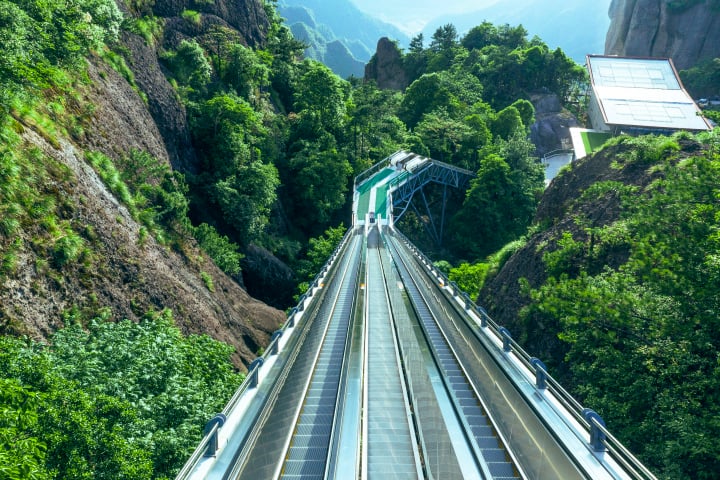Something bizarre is happening to Siberia and it’s got experts all over the world worried. It seems that the vast Russian province is simply cleaving into unexplained giant craters that are so huge they can be viewed from outer space!
It all started in 2013, when helicopter pilots spotted a mysterious hole in the permafrost while flying over the Yamal region in northern Russia. A few days later, reindeer herders spotted another hole, and a third crater was found not long after. In February this year four new ‘giant’ craters were found, surrounded by dozens of ‘baby’ funnels, some of which had turned into lakes. And a leading geological expert predicted that about 30 more craters are waiting to be discovered.
Photo: Vasily Bogoyavlensky
Worried scientists turned to satellite images for answers, and their worst fears were confirmed – the present day Russian landscape appears severely pockmarked when compared with old satellite imagery. The images suggest that the phenomenon is more widespread than first suspected – old images show no sign of craters but there’s now a 100 by 50-meter lake surrounded by 20 smaller holes filled with water.
Photo: Vasily Bogoyavlensky
Experts were flabbergasted at first, but when locals at Antipayuta, on the Yamal Peninsula, reported seeing a flash of light near a crater, they realised it was probably the result of exploding gas. And that’s the most plausible explanation at hand now – the permafrost is melting due to climate change, leading to methane gas eruptions which in turn result in these craters.
Photo: Vasily Bogoyavlensky
But a few scientists are not convinced by this theory. According to Carolyn Ruppel, chief of the U.S. Geological Survey’s Gas Hydrates Project, “Generic methane hydrates in permafrost settings are normally not stable above 200 meters depth. The craters are far shallower than that, so tapping into dissociating methane hydrate is probably unlikely.” Instead, she suggested a simpler explanation, related to pingos, which are mounds of earth-covered ice in the Arctic and subarctic regions.
Photo: Yamalo-Nenets Autonomous region governor’s press-service
“A pingo is a plug of ice that forms near the surface over time and has a small mound or hill on top,” Ruppel explained. “When an ice plug melts rapidly – as may have been, thanks to unseasonably warm temperatures in Siberia over the past year – it can cause part of the ground to collapse, forming a crater.” But most experts contended this theory, saying that the ejected rocks found at the rim of the craters suggest an explosion, not a collapse.
Photo: Vasily Bogoyavlensky
In July 2015, after conducting an expedition to one of the craters, Professor Vasily Bogoyavlensky told the Siberian Times that it was indeed most likely caused by an exploding pingo. “It was a pingo or bulgunnyakh (mounds with an ice core common for Arctic and sub-Arctic regions), and then, due to the Earth’s heat flow this pingo starts to thaw and its half melted ice core is filled with gas that originates from the depth through cracks and faults in the ground,” he said.
Photo: Yamalo-Nenets Autonomous region governor’s press-service
Even before the discovery of the craters, scientists were concerned about rising temperatures in the region. There was already scientific concern that Lake Baikal – the world’s largest and oldest freshwater lake – could be sitting on a ‘time bomb’ that’s ready to explode. They now fear that continued rise of temperature could create ideal conditions for the formation of more craters. Permafrost at these sites could have so much methane hydrates locked inside that the total explosive power of the craters could be the equivalent of about 11 tons of TNT.
Photo: aerial map of Yamal Peninsula
While the exact causes of Siberia’s giant craters remain a mystery, authorities are trying to find an ‘urgent’ strategy to ensure safety of the people in the region. “It is important not to scare people, but this is a very serious problem,” said Professor Vasily Bogoyavlensky, deputy director of the Moscow-based Oil and Gas Research Institute. “We must research this phenomenon urgently to prevent possible disasters. We cannot rule out new gas emissions in the Arctic and in some cases they can ignite.”
Photo: Vladimir Pushkarev/Russian Centre of Arctic Exploration
“We know of seven craters in the Arctic area,” he told The Siberian Times. “Five are directly on the Yamal peninsula, one in Yamal Autonomous district, and one is on the north of the Krasnoyarsk region, near the Taimyr peninsula. We have exact locations of only four of them. But I am sure there are more craters on Yamal, we just need to search for them.”
Photo: Vladimir Pushkarev/Russian Centre of Arctic Exploration
“We need to answer now the basic questions: what areas, and under what conditions, are the most dangerous,” he added. “These questions are important for the safe operation of the northern cities and the infrastructure of oil and gas complexes.”





















